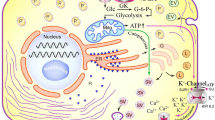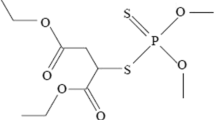Abstract
The effect of the in vivo administration of hexachlorobenzene (HCB) (100 mg/100 g bw) for 30 days, on the activities of brown adipose tissue (BAT) lipogi.e. malic enzyme (ME), and glucose-6-enic enzymes, phosphate dehydrogenase (G6PD) and the mitochondrial non lipogenic enzyme, L-glycerol-3-phosphate dehydrogenase (LG3PD), was studied in male Wistar rats, submitted to various neurohormonal manipulations. BAT ME, G6PD and LG3PD activities showed significant reductions in response to HCB treatment both in euthyroid and surgically thyroidectomized rats, showing that the effect does not depend on the presence of thyroid hormones. These results differ from those obtained for hepatic ME and G6PD activities, which increased in HCB intoxicated rats without alteration in LG3PD. HCB decreased BAT ME activity under BAT denervation. Administration of HCB resulted in time and dosedependent decreases in the activity of BAT malic enzyme. The basal activity of ME was increased in hypothyroid rats, while that of LG3PD was reduced. A stimulatory effect of receptor-saturating doses of triiodothyronine (T3) (50 μg/100 g body weight) was observed on BAT ME and LG3PD activities in thyroidectomized rats, showing that the enzymes responded to thyroid hormone stimulation in a normal manner. The stimulatory effect of saturating doses of T3 on ME and LG3PD was reduced by HCB. The results presented herein unequivocally show that brown adipose tissue is a specific target in HCB-induced toxicity, which in turn involves severe alterations in the regulation of BAT lipogenesis.
Similar content being viewed by others
References
Courtney, K.D. Hexachlorobenzene: A review. Environ. Res. 1979, 20: 225.
Kleiman de Pisarev D.L., Ríos de Molina M. del C., San Martín de Viale L.C. Thyroid function and thyroxine metabolism in hexachlorobenzene-induced porphyria. Biochem. Pharmacol. 1990, 39: 817.
Lambrecht R.W., Ertuck E., Gruden E.E., Peters H.A., Morris C.R., Bryan G.T. Hepatic carcinogenicity of chronically administered hexachlorobenzene in rats. Fed. Proc. 1986, 42: 786.
Rozman K., Gorski J.R., Rozman P., Parkinson A. Reduced serum thyroid hormone levels in hexachlorobenzene induced porhyria. Toxicol. Lett. 1986, 30: 71.
Smith A.G., Dinsdale D., Cabral J.R.P., Wright A.L. Goitre and wasting induced in hamster by hexachlorobenzene. Toxicology 1987, 60: 343.
Matsumura F. How important is the protein phosphorylation pathway in the toxic expression of dioxin-type chemicals? Biochem. Pharmacol. 1994, 48: 215.
Himms-Hagen J. Brown adipose tissue and cold aclimation. In: Trayhurn P., Nicholls D.G. (Eds.), Brown adipose tissue. Arnold, London, 1986, p.214.
McCormack J.G. The regulation of fatty acids synthesis in brown adipose tissue by insulin. Prog. Lipid Res. 1982, 21: 195.
Himms-Hagen J. Brown adipose tissue thermogenesis: interdisciplinary studies. FASEB J. 1990, 4: 2890.
Carvalho S.D., Negrao N., Bianco A.C. Hormonal regulation of malic enzyme and glucose-6-phosphate dehydrogenase in brown adipose tissue. Am. J. Physiol. 264 (Endocrinol. Metab. 27), 1993: E874.
Kleiman de Pisarev D.L., Ferramola de Sancovich A.M., Sancovich H.A. Hepatic indices of thyroid status in rats treated with hexachlorobenzene. J. Endocrinol. Invest. 1995, 18: 271.
Hsu R.Y., Lardy H.A. Malic enzyme. Methods Enzymol. 1969, 13: 230.
Lee C.J. Glucose 6-phosphate dehydrogenase from mouse. Methods Enzymol. 1982, 89: 252.
Gardner R.S.A. A sensitive colorimetric assay for mitochondrial LGlycerophosphate dehydrogenase. Anal. Biochem. 1974, 59: 272.
Bottomley R.H., Pitot N.C., Potter V.R., Morris N.P. Metabolic adaptations in rat hepatomas v. reciprocal relationship between threonine dehydrase and glucose-6-phosphatase dehydrogenase. Cancer Res. 1963, 23: 400.
Lee Y.P., Lardy H.A. Influence of thyroid hormones on L-glycerolphosphate dehydrogenases on other dehydrogenases in various organs of the rat. J. Biol. Chem. 1965, 240: 1427.
Bradford M.M. A rapid and sensitive method of quantitation of microgram quantities of protein utilizing the principle of protein-dye binding. Anal. Biochem. 1976, 72: 248.
Kleiman de Pisarev D.L., Sancovich H.A., Ferramola de Sancovich A.M. Enhanced thyroxine metabolism in hexachlorobenzene-intoxicated rats. J. Endocrinol. Invest. 1989, 12: 767.
Oppenheimer J.H., Coulombe P., Schwartz H.L., Gutfeld N.W. Non linear (amplified) relationship between nuclear occupancy by triiodothyronine and the appearance rate of hepatic ?-glycerophosphate dehydrogenase and malic enzyme in the rat. J. Clin. Invest. 1978, 61: 987.
Bianco A.C., Silva J.E. Optimal response of key enzymes and uncoupling protein to cold in BAT depends on local T3 generation. Am. J. Physiol. 253 (Endocrinol. Metab. 16), 1987: E255.
Smith A.G., Francis J.E., Green J.A., Greig J.B., Wolf R.C., Manson M.M. Sex-linked hepatic uroporphyria and the induction of cytochromes P450IA in rats caused by hexachlorobenzene and polyhalogenated biphenyls. Biochem. Pharmacol. 1990, 40: 2059.
Ohkawa K.I., Vogt M.T., Farber E. Unusually high mitochondrial alpha-glycerophosphate dehydrogenase activity in rat brown adipose tissue. J.Cell Biol. 1969, 41: 441.
Gondret F., Mourot J., Bonneau M. Developmental changes in lipogenic enzymes in muscle compared to liver and extramuscular adipose tissues in the rabbit (Oryctolagus cuniculus). Comp. Biochem. Physiol B. Biochem Mol. Biol. 1997, 117: 259.
Viluksela M., Stahl B.V., Rozman K.K. Tissue — specific effects of 2,3,7,8- tetrachlorodibenzo-p-dioxin (TCDD) on the activity of phosphoenol pyruvate carboxykinase (PEPCK) in rats. Toxicol. Appl. Pharmacol. 1995, 135: 308.
Gorski J.R., Weber L.W.D., Rozman K. Tissue — specific alterations of the novo fatty acid synthesis in 2,3,7,8 tetrachlorodibenzo-p-dioxin (TCDD)- treated rats. Arch. Toxicol. 1988, 62: 146.
Bath H.S., Saggerson E.D. Comparison of triacylglycerol synthesis in rat brown and white adipocytes. Effects of hypothyroidism and streptozotocin-diabetes on enzyme activities and metabolic fluxes. Biochem. J. 1988, 250: 325.
Freake H.C., Schwartz H.L., Oppenheimer J.H. The regulation of lipogenesis by thyroid hormone and its contribution to thermogenesis. Endocrinology 1989, 125: 2868.
Blennemann B., Leahy P., Kim T.-S., Freake H.C. Tissue-specific regulation of lipogenic mRNAs by thyroid hormone. Mol. Cell. Endocrinol. 1995, 110: 1.
Loaiza A., Kleiman de Pisarev D.L., Randi A., Seisdedos M.T., Ferramola A.M., Sancovich H.A., Santisteban P. Regulation of thyroid homone responsive enzymes gene expression in liver of hexachlorobenzene intoxicated rats. Thyroid 1997, 7 (Suppl. 1): 85.
Sande S., Privalsky M.L. Identification of TRACs (T3 Receptor-associating Cofactors), a family of cofactors that associate with, and modulate the activity of nuclear hormone receptors. Mol. Endocrinol. 1996, 10: 813.
Hahn M.E., Goldstein J.A., Linko P., Gasiewicz T.A. Interaction of hexachlorobenzene with the receptor for 2,3,7,8-tetrachlorodibenzo-p-dioxin in vitro and in vivo. Arch. Biochem. Biophys. 1989, 270: 344.
Enan E., Matsumura F. Regulation by 2,3,7,8-tetrachlorodibenzo-p-dioxin (TCDD) of the DNA binding activity of transcriptional factors via nuclear protein phosphorylation in guinea pig adipose tissue. Biochem. Pharmacol. 1995, 50: 1199.
Randi A., Sancovich H., Ferramola de Sancovich A.M., Loaiza A., Krawiec L., Kleiman de Pisarev D.L. Hexachlorobenzene-induced alterations of rat hepatic microsomal membrane functions. Toxicology 1998, 125: 83.
Hardie D.G. Regulation of fatty acid synthesis via phosphorylation of acetyl CoA carboxylase. Prog. Lipid Res. 1989, 28: 117.
Author information
Authors and Affiliations
Rights and permissions
About this article
Cite this article
Alvarez, L., Randi, A., Alvarez, P. et al. Effect of hexachlorobenzene on NADPH-generating lipogenic enzymes and L-glycerol-3-phosphate dehydrogenase in brown adipose tissue. J Endocrinol Invest 22, 436–445 (1999). https://doi.org/10.1007/BF03343587
Accepted:
Published:
Issue Date:
DOI: https://doi.org/10.1007/BF03343587




